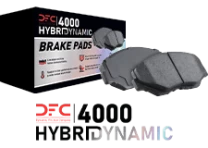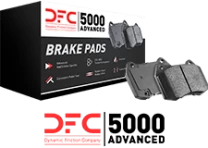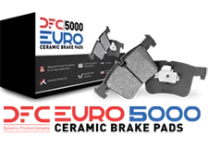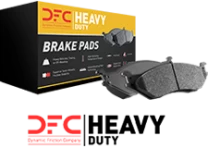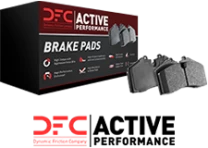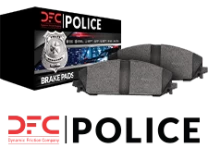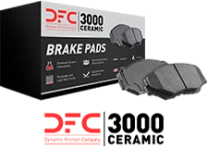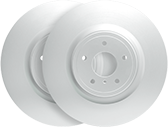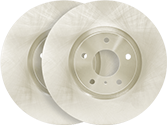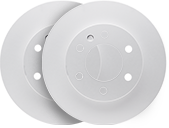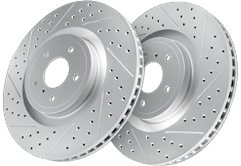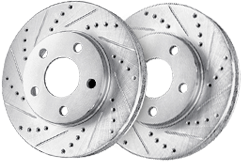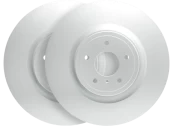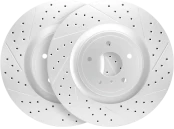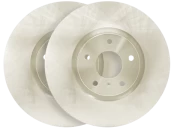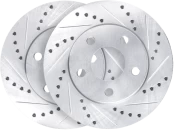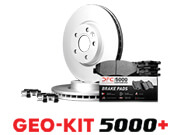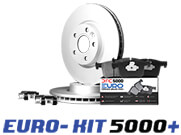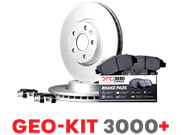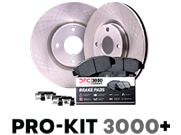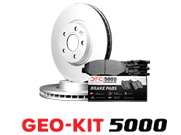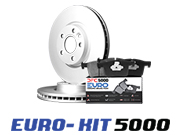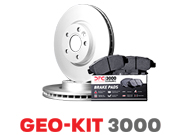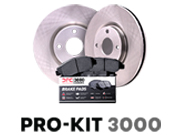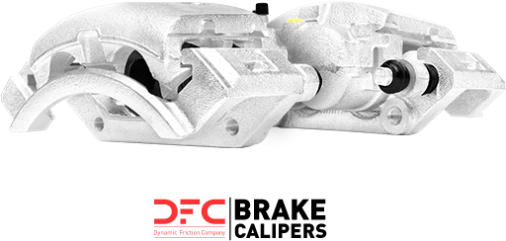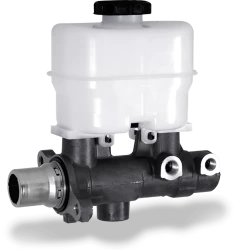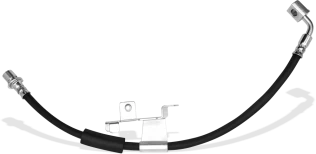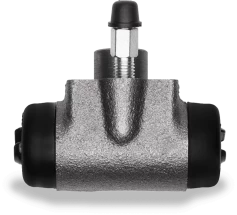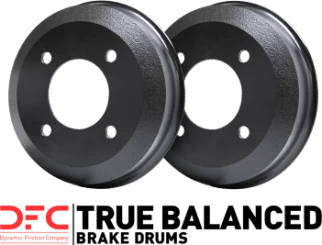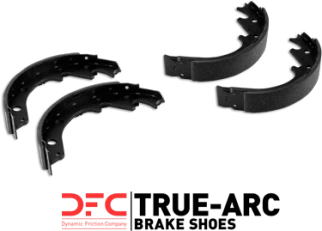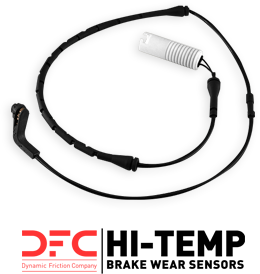In need of a new brake rotor but unsure where to start? Selecting the right one is easier than you think. This article offers practical advice on how to choose a brake rotor, targeting your vehicle’s requirements, your driving style, and your typical driving conditions. Dive in to find a tailor-made solution for confident, safe driving.
Key Takeaways
- Selecting the right brake rotors involves considering factors such as the measurement for fit, the make and model of your vehicle, your driving style, and the environmental conditions you typically drive in. All these factors influence the performance and your choice of rotor.
- Brake rotors come in different types, including drilled, slotted, drilled & slotted, and blank or smooth. Each type has its pros and cons, and the choice depends on your specific needs and preferences.
- The material of the brake rotor also plays a crucial role. Different materials offer different advantages and disadvantages in terms of durability, heat dissipation, and resistance to wear. The choice of material should match your driving conditions and preferences.
- Brake rotors are available in a variety of materials including cast iron, stainless steel, layered steel, high carbon, ceramic, and zinc-coated. Each material offers unique advantages and is suited to specific applications based on their durability, heat dissipation capabilities, and resistance to wear.
Things To Consider When Choosing A Break Rotor For Your Vehicle
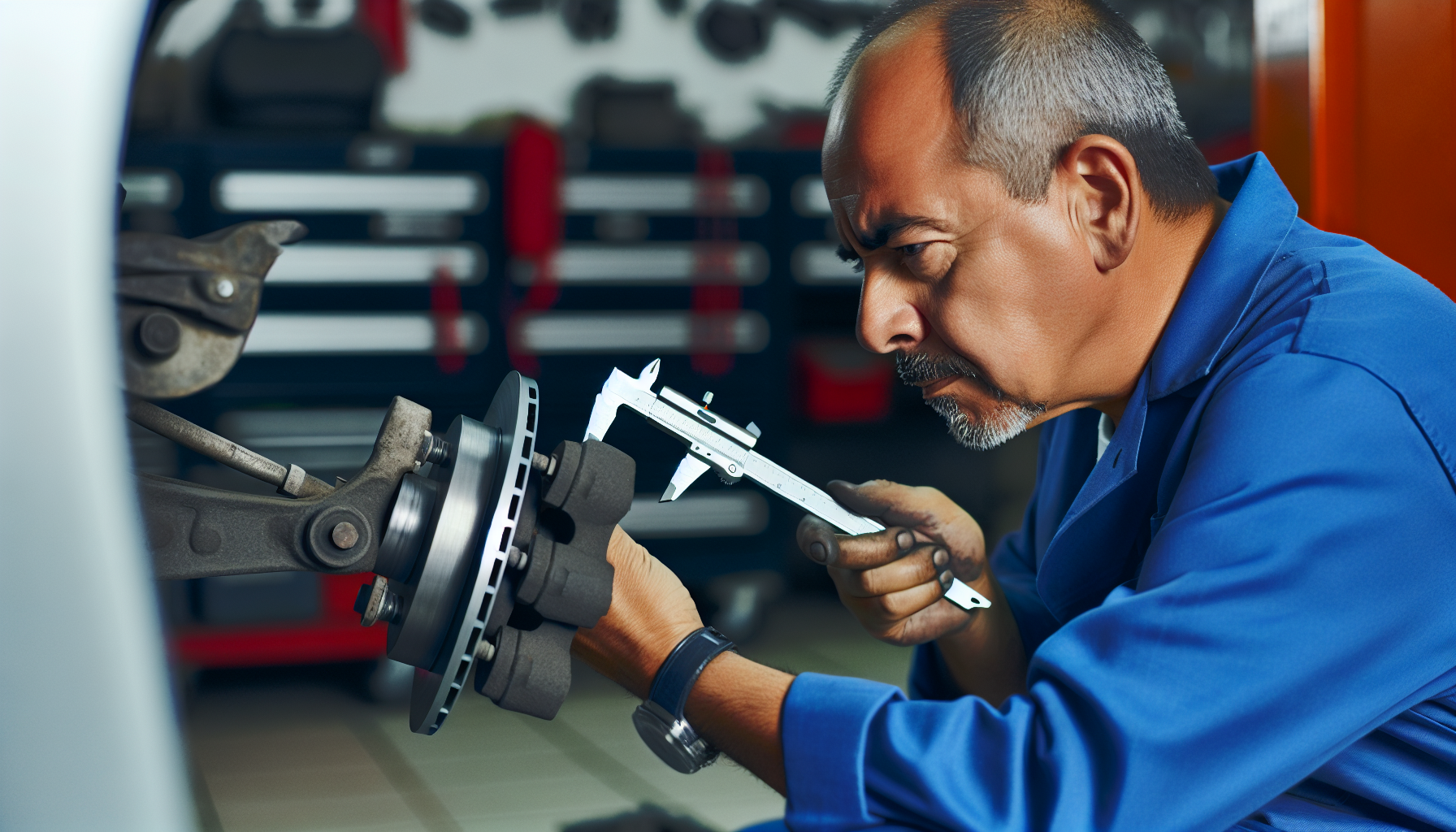
Choosing the right brake rotor involves more than just appearance and cost. It’s crucial to know what your vehicle requires, as well as your personal preferences as a driver. Take into account these important elements:
Measure Your Current Rotor’s Size (If Possible To Obtain)
To guarantee a proper fit, it is important to measure your rotor before purchasing. You can easily let a professional mechanic determine this or read your vehicle’s manual but if chosen to do this on your own, here’s a step-by-step instruction.
How To Measure Your Vehicle’s Rotor Size
- Ensure your vehicle is on a flat surface and the parking brake is engaged for safety.
- Remove the wheel: Loosen the lug nuts and lift your car using a jack. Remove the lug nuts completely and take off the wheel.
- Locate the brake rotor: It’s the large disc located behind your wheel.
- Measure the diameter: Use a measuring tape to measure the distance across the widest part of the rotor, from one edge straight across to the other. This is the diameter of your rotor.
- Measure the thickness: Using a micrometer or dial indicator, measure the thickness of the rotor at the thickest point. This is typically done by measuring 10mm from its outer circumference.
- Record these measurements and compare them with the manufacturer’s specifications for your vehicle to ensure you have the correct size.
Remember, always consult your vehicle’s manual or speak with a professional if you’re unsure. While you can get the measurement of your brake rotors on your own, it is best to let the experts do this.
Your Vehicle’s Make And Model
The selection of brake rotors is greatly determined by the make and model of your vehicle. This is because different vehicles have varying specifications, and the brake rotors must fit these specifications to ensure optimal performance and safety.
For example, a compact car might require smaller, lighter rotors, while a heavy-duty truck might need larger, more robust rotors to handle the increased weight and power.
The design of the vehicle also plays a role, as some models might have unique requirements for brake rotor size or shape.
Your Driving Style
The way you drive plays an important role in determining the most suitable brake rotor for your vehicle. If you tend to drive aggressively or often tow heavy loads, considering rotors with advanced heat dissipation capabilities like cross drilled ones may be necessary. On the other hand, for everyday casual driving, regular rotors might suffice.
Understanding your individual way of operating a vehicle is vital in choosing suitable rotors that can cater to your specific habits and ensure optimal performance and longevity of your brake system.
Where You Live: Terrain and Weather Conditions
The type of rotor best suited for your vehicle is dependent on the terrain and weather conditions in which you typically drive. If you frequently make stops while driving in urban areas, it is important to choose rotors that can maintain consistent performance.
Conversely, those living in mountainous or hilly regions should opt for rotors with high heat dissipation capabilities to handle downhill braking.
Factors such as humidity can greatly impact the effectiveness of brake rotors. In environments with high levels of moisture, adhesive wear may occur leading to a decrease in braking efficiency over time. On the other hand, lower humidity areas could result in fatigue wear on brake components. As such, when selecting brake rotors it is crucial to consider your typical driving conditions and any potential buildup of brake dust that may affect their performance.
What Kinds of Brake Rotors Are There?
| Type of Rotor | Ideal Driving Style | Ideal Location | Weather Considerations | Pros | Cons |
|---|---|---|---|---|---|
| Drilled Only | Street Performance | Urban areas with even terrains | Performs well in wet conditions | Excellent in wet conditions, long lifespan, better friction on wet roads | Can wear unevenly, may develop cracks under high heat, not suitable for racing |
| Slotted Only | Heavy Hauling/Towing, Off-Road | Uneven Terrains | Performs well in normal weather conditions | Efficient heat dissipation, reduced brake fade, responsive stopping | not good in wet roads and has a shorter lifespan, can cause brake pads to wear out faster, potential shaking sensation during high-speed braking |
| Drilled & Slotted | Mixed Driving Styles | Uneven Terrains, Warm Climates | Performs well in both wet and dry conditions | Combines benefits of drilled and slotted rotors, can handle heat and heavy hauling | Not recommended for performance racing due to potential for cracking |
| Blank or Smooth | Daily Driving, Racing | Standard Terrains, Racing Tracks | Performs well in consistent weather conditions | Quiet braking, handles high-speed braking heat well, consistent braking performance | No major cons, but some drivers may prefer the look/performance of slotted or drilled rotors |
Wondering about the different kinds of brake rotors you can get for your car? Here’s a simple list:
- Drilled – These have holes punched through them. They’re not just for looks; the holes help keep the brakes cool and get rid of water on rainy days.
- Slotted – These have lines cut into them. The lines help wipe away stuff like dust from the brake pads and also help with heat.
- Drilled & Slotted – A combo of the two above. They’ve got holes and lines, which means they get the benefits of both: they stay cool and clean.
- Blank or Smooth – These are your basic, no-frills brake rotors. Smooth all over, they do the job without any extra bells and whistles.
Even if car parts aren’t your thing, you can tell these apart easily. If you’re new to car maintenance or haven’t bought brake parts before, no worries—knowing what these look like will help you figure out what’s on your car now.
Drilled Only Rotors
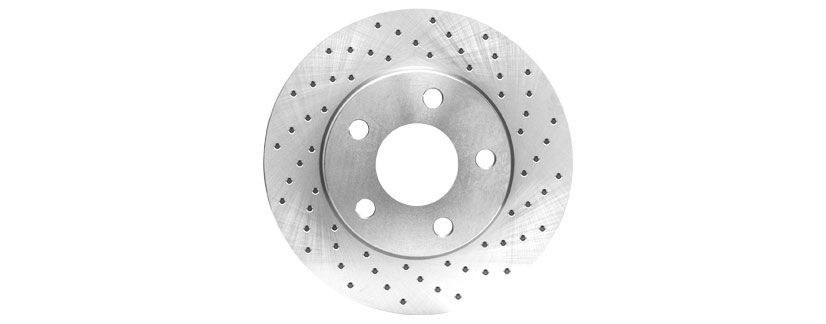
Drilled rotors, easily spotted by their distinctive pattern of holes, are a top choice for street performance and are especially handy in consistently wet conditions. These rotors are a popular choice among performance enthusiasts and those who prioritize aesthetics along with functionality.
Pros:
Drilled rotors are a great choice if you live in a rainy area. They handle wet conditions well, last a long time, and provide more friction in wet roads than slotted rotors. This is because the holes in the rotor allow water to escape, drying the brake system when it’s wet, thus better brake performance when it’s wet outside.
Cons:
Drilled rotors have some downsides despite their benefits. They can wear unevenly and may develop cracks under high heat, like during races. Over time, they can also look strange due to their wear pattern, especially if the holes aren’t staggered. This doesn’t affect their performance, but might bother some drivers.
They’re not suitable for race cars due to their inability to handle repeated heating and cooling cycles. However, they’re just fine for regular street driving.
Slotted Only Rotors
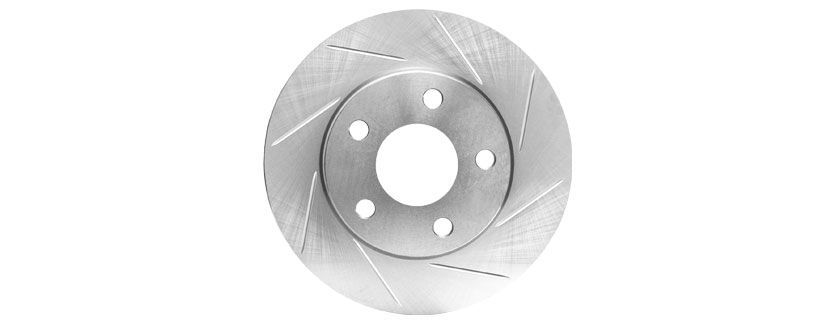
Slotted rotors are ideal for Street Performance, Autocross/Track, Towing/Hauling, and Off-Road driving. If you live in an area with irregular landscapes and uneven terrain, slotted rotors are the best choice for you.
Pros:
Slotted rotors are an excellent choice for vehicles that are frequently driven in challenging terrains, or for those who often haul or tow heavy loads. They are particularly effective in these conditions due to their design which allows for efficient heat dissipation and reduced brake fade, which in turn provides a more responsive and prompt stop.
This style of brake rotor delivers improved consistency with every stop, by creating an escape route for the gasses and heat that are generated during braking. You can rely on these pads to deliver effective braking even in heavy duty vehicles.
Cons:
While slotted brake rotors have their benefits, they also come with a few downsides. They typically don’t last as long as other brake rotor types, and they can potentially cause your brake pads to wear out faster. When you’re slowing down from high speeds, you might feel a shaking sensation from the rotors. This doesn’t impact their performance, but the noise could be off-putting for some drivers.
Drilled & Slotted Rotors
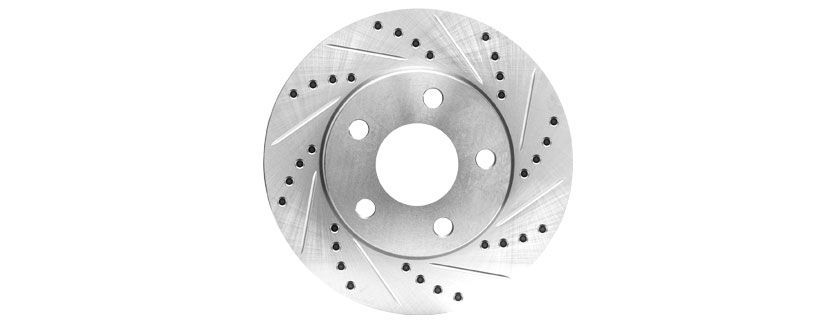
Drilled and slotted rotors are the optimal choice when it comes to performance and longevity.
Pros:
Drilled & slotted brake rotors offer the benefits of drilled and slotted rotors together. Like drilled rotors, they work well for wet climates where frequent rain is a consideration and with the slotted features this can also handle heat and heavy hauling as well.
These are the best brake rotors if you are considering to drive in extremely uneven terrains in warm climates. For instance, if you often find yourself traversing the rocky, undulating landscapes of the Arizona desert, where the climate is typically warm and the terrain is far from even, these rotors will serve you well.
Cons:
While drilled & slotted rotors offer a variety of benefits, they are not recommended for performance racing since the drilling makes them vulnerable to cracking. This is due to the extreme heat and pressure conditions that racing rotors are subjected to. When exposed to these conditions, the drilled holes can become stress points where cracks can begin to form. Over time, these cracks can grow and lead to rotor failure.
Blank Rotors
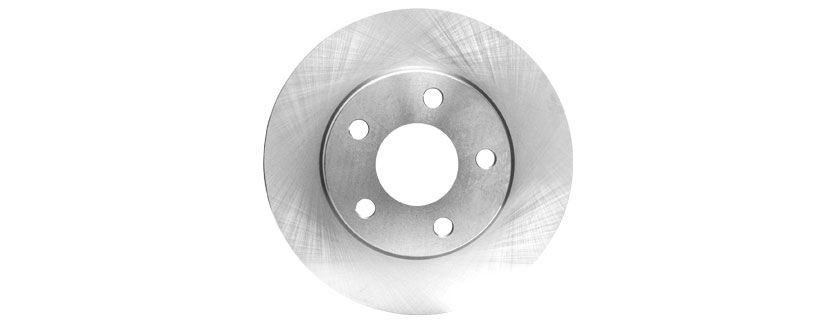
Blank Rotors are the best choice for normal daily driving in standard terrains and consistent weather conditions. On the contrary, blank rotors are also the best choice when doing extremely aggressive driving such as racing.
Pros:
If your driving routine is standard, such as commuting to work or going grocery shopping, and you don’t drive aggressively or go to uneven terrains or do hauling, plus you value a quiet braking system, then smooth rotors could be your ideal choice.
On the other hand, another pro of blank rotors is that despite being the ideal choice for everyday commuting, also excel in racing environments. The lack of drilled holes or slots means there are no weak points where cracks can form under the extreme heat and pressure conditions of racing.
This solid surface can handle the intense heat generated during high-speed braking better than its drilled or slotted counterparts. Furthermore, the smooth surface of blank rotors provides the maximum amount of contact area between the rotor and brake pad, allowing for more consistent braking performance.
Cons:
While there are few drawbacks to using blank rotors, some drivers might wrongly assume that drilled or slotted rotors are specifically the best. This isn’t always the case; the best rotor for you largely depends on your driving habits and the kind of stopping power you’re looking for. So, don’t be swayed by common misconceptions—choose the brake rotor that aligns with your vehicle’s use and your personal driving style.
If the brake rotor you have works fine, just get the same type when you replace it. If you need a rotor for something specific, like rainy days or racing, you’re all set to pick the right one for your car.
Brake Rotor Material Types
| Material Type | Driving Style | Pros | Cons |
|---|---|---|---|
| Cast Iron | Regular Driving, Budget-conscious Consumers | Even brake pad wear Cost-effective |
Prone to rust and corrosion Limited durability |
| Stainless Steel | High-performance, Regular Driving with Budget Flexibility | Long-lasting Corrosion resistance |
Expensive Warping under extreme heat |
| Layered Steel | High-performance, Heavy-duty Vehicles | Durability Resistance to high temperatures and pressures |
Expensive Heavier Requires more maintenance |
| High Carbon | High-performance, Road Safety-focused Consumers | Smooth performance Excellent heat dissipation Resistance against cracking |
Higher price |
| Ceramic | Premium Performance, Moderate Conditions | Lightweight Exceptional heat resistance Long-lasting durability |
Expensive Less suitable for extremely cold weather or rigorous racing |
Not only the design, but the material of your brake rotors also plays a significant role. Here are some options to consider, categorized by the material they are made from.
Cast Iron
Cast iron is a popular choice for brake rotors due to its cost-effectiveness and suitability for regular driving. It ensures even brake pad wear, leading to smoother performance.
However, cast iron rotors are prone to rust and corrosion, impacting their durability and functioning over time. Proper maintenance and regular use can extend their lifespan to between 30,000-70,000 miles.
Stainless Steel
Stainless steel rotors are durable and resist corrosion, which helps them last longer. However, they are more expensive and can warp under extreme heat, especially during high-speed braking. They also tend to wear down brake pads faster due to their hardness.
Layered Steel
Layered steel rotors, made from multiple steel sheets, are a reliable choice for high-performance or heavy-duty vehicles due to their durability, resistance to high temperatures and pressures, and excellent heat dissipation. However, they are more expensive, heavier, and may require more frequent maintenance to prevent rust and corrosion, especially in humid or salty environments.
High Carbon
High carbon brake rotors are made from a blend of iron and a high proportion of carbon, resulting in a durable material capable of withstanding high temperatures, a crucial requirement for any brake rotor. Known for smooth performance, reduced noise, and excellent heat dissipation, high carbon rotors enhance brake efficiency and road safety.
Their high metallic and carbon content provides resistance against cracking under intense stress, minimizing unwanted noises or vibrations during braking. This results in better overall performance and durability, allowing them to last up to 93,000 miles when used on roads. However, these rotors can come at a higher price compared to other types.
Ceramic
Ceramic rotors are a premium choice renowned for their ability to provide:
- Light weight feature
- Exceptional resistance to heat
- High-performance braking capability
- Long-lasting durability
- Resistance against harmful elements such as salt and water
These advanced rotors may not be the most budget-friendly option due to high production costs. While they can perform well in moderate conditions, extremely cold weather or rigorous racing circumstances might not suit them best.
Wrap Up!
This blog provides a comprehensive guide on choosing the right brake rotor for your vehicle, considering factors like the vehicle’s make and model, driving style, and typical driving conditions. It explains the different types of rotors – drilled, slotted, drilled & slotted, and blank or smooth, along with their pros and cons. The blog also discusses the significance of the rotor material, detailing options like cast iron, stainless steel, layered steel, high carbon, and ceramic. It concludes with the cost implications of replacing brake rotors, and the possibility of self-installation.
How much should I expect to spend on changing rotors?
The cost of replacing brake rotors is influenced by various factors such as the rotor’s brand, type, and labor charges. Typically, brake rotors cost between $30 and $75 each, but prices can range from $35 to $300 per axle depending on quality and brand. Installation fees also contribute to the total cost, with prices ranging from around $150 to $300 per axle. The specific make and model of your vehicle can also impact the price of brake components.
Can I install brake rotors myself?
Yes, with the right tools and some mechanical knowledge, you can install brake rotors yourself, this is even better because it can save you money compare to going to a shop to change your rotors. However, if you’re unsure, it’s best to have a professional do it to ensure safety and proper installation.

 UNITED STATES
UNITED STATES
